Up Pompeii It's Not
Caligula is a crap movie.
I just wanted to put my cards on the table and tell you how I feel about the movie up front. It fails as an exploitation piece by trying to be an arthouse movie. It fails as an arthouse movie by having too much exploitation material in it. It's too gory to be a piece of erotica, and too much of a Fellini ripoff to be a proper horror movie. To be the classic of cinema it wanted to be, this movie needed somebody like Fellini, Ken Russell or Kubrick at the helm. What it got was Bob Guccione trying to be William Randolph Hearst.
Caligula is the story of Gaius Julius Caesar Augustus Germanicus (12 - 41AD), third emperor of the Roman Empire. The adopted grandson of Emperor Tiberius (Peter O'Toole), Gaius earned the nickname Caligula (Little Boots) accompanying his father General Germanicus on his military campaigns. He withdrew to the island of Capri where his grandfather held court following the mysterious deaths of a number of family members and succeded Tiberius on the old man's death in 37AD. There is little documentary information about Caligula that is not coloured by negative propaganda portraying him as a barking mad pervert, but that wouldn't make a very good movie, would it?
The story behind the movie is far more fascinating than the movie itself. Penthouse Magazine publisher Bob Guccione had a vision to make an erotic epic of the cinema. He was inspired to make Caligula when he was approached for funding by Myra Breckinridge author Gore Vidal. Vidal had developed a screenplay based on an unproduced tv mini-series treatment by Roberto Rosselini. A regular contributor to Penthouse, Vidal knew Guccione was interested in movie investment having put money into Chinatown and Day of the Locust. Co-producing with Franco Rosselini (Roberto's nephew), Guccione got stuck into bringing Caligula to the screen. With Vidal's script in hand, the producers hired Fellini's set designer Danilo Donati to come up with the 64 sets and 3592 costumes involved and started gathering together a cast of international repute.
Actually, the cast is a mixed bag of top line British thesps - Malcolm McDowell, Helen Mirren, Peter O'Toole and Sir John Gielgud - and Italian actors. Maria Schneider was signed to play Caligula's sister Drusilla, but the actress who had no qualms about the idea of sticking a well-buttered finger up Marlon Brando's khyber in Last Tango In Paris balked at the incestuous scenes between Drusilla and Caligula. She dropped out of the movie to be replaced by Teresa Ann Savoy, a Tinto Brass protégé.
Finding a director for the movie proved a more difficult task. Negotiations to sign up both John Huston and Lina Wertmuller (who had wanted Jack Nicholson for the lead) had fallen through when Guccione happened upon a screening of Salon Kitty by young Italian director Tinto Brass. Impressed by what he saw, Guccione signed Brass to direct.
Housed at Dear Studios in Rome, the movie was hardly started when it ran into budgetary problems causing a number of corners to be cut, not least in Danilo Donati's sets. Writer Gore Vidal and Director Tinto Brass immediately clashed over Vidal's assertions in Time magazine that directors were parasites feeding off the genius of writers, and that the former only had to follow the instructions of the latter as written down in the screenplay. Brass banned Vidal from the lot, and Guccione was forced to side with the director as technically the screenplay was a fait accompli at that point. Brass however was still not happy with the screenplay, or the amount of onscreen nookie Guccione wanted in the movie. Roping in Malcolm McDowell as a co-author, Brass set to rewriting the script (with the result that Vidal disowned the movie and insisted on his credit being taken off the finished product.)
At the end of Principal Photography, Guccione took over the picture completely, firing Tinto Brass for going over budget and shooting what Guccione considered to be ugly sex scenes. He and Italian editor Nino Baragli (who had cut Salo, or the 120 Days of Sodom) set to cutting the film together. Under Guccione, continuity went out of the window and with friend Giancarlo Lui, Guccione shot new hardcore sex scenes featuring his Penthouse Pets to replace and supplement the orgy scenes shot by Brass.
On 21st November 1979, four years on from the start of production, the film opened in the UK (Italy had seen it in August, but the UK and US premieres were the important ones). The critics trashed it. Roger "Two Thumbs Up" Ebert walked out and gave the picture zero stars.
So what went wrong?
As eroticists go, Tinto Brass is a lot of fun. I have a soft spot for his 2003 comedy opus Cheeky (Trasgedire) with Yuliya Mayarchuk which obsesses on the aforementioned young lady's exceptionally photogenic derriere. Tinto Brass definitely knows how to do erotic. He also knows how to do perverse - disturbing sexual imagery. Caligula falls into the latter category. It is simply not erotic. Exploitative, yes, perverse, yes, but erotic definitely not. Especially not with Bob Guccione's XXX-rated inserts. It is certainly not the pornographic epic envisaged by Guccione - I know pornography, and this isn't pornography. The sex in the movie is ugly and there's way too much violence to describe the movie as pornographic, so if you're after a quick perve, this movie isn't for you. If anything, Caligula is Grindhouse meets Giallo - piling extreme image on extreme image to see how far you can push the audience before it buries its face in its popcorn.
One thing that baffles me is that Guccione was working with photographer/ cinematographers in his core business who could make erotic movies with a decent storyline - Paul Nevitt (aka Andrew Blake) or Eric Mond spring to mind - and yet he was chasing after first mainstream directors and then Tinto Brass, who wouldn't have produced the kind of movie Penthouse readers would have expected.
The failure of Caligula is most definitely not Brass's. The interview Brass gives on the Extras disc - Tinto Brass: The Orgy Of Power indicates the much cleverer movie that Caligula could have been had Guccione and his hangers-on left him the hell alone to cut the movie. As it was, the movie was taken off him and edited effectively by Guccione. Reading between the lines, one can deduce that Giancarlo Lui who co-directed the XXX rated inserts featuring the Penthouse Pets with Guccione must have been instrumental in the movie being taken off Brass.
Brass's vision of Caligula was that of the ultimate anarchist. Caligula wasn't crazy as history has portrayed him, he was a spolit child with ultimate power of life and death with a whole Empire to play with. When viewed with that idea at the back of one's mind, the Alternative Version becomes the best and most lucid of the three cuts of the movie, and actually isn't half bad.
I'd say your best bet coming to the movie fresh is to watch first the Uncut version, then the Alternative cut (with the commentary track on) and finally the theatrical cut. Watching the theatrical cut directly after the Uncut version makes your realise how completely hacked to pieces in the cutting room the movie was. I'd advise against trying it in one sitting, as at over two-and-a-half hours, the Uncut version is bum-numbingly long and you'll feel every minute of the 101 of the theatrical cut.
The Uncut version sports a number of orgy scenes which will undoubtedly make this set of discs a best-seller in the UK with fairly graphic depictions of a number of sex acts that would normally have got the discs slapped with an R18 rating from the BBFC. The orgy scenes in Caligula are completely and utterly gratuitous (and frankly completely unerotic).
Video
Frankly I was shocked by the video quality of this release. Having watched a number of Arrow Films' releases of Tinto Brass movies I knew what to expect imagewise from that director. The movie has the customary soft-focus, grainy look beloved of Bob Guccione in the pages of his famous Penthouse magazine. Presented in something that looks roughly 2:1 (there are very thin black bars top and bottom on the image so it isn't 1.78:1 or 1.85:1), but anamorphically enhanced, there are a lot of things wrong with the image. Bright reds produce a stepped banding, and some scenes - particularly Peter O'Toole's scene in the pool - demonstrate terrible compression artefacts like a Saturday afternoon movie on BBC2 on cable.
Audio
The extended cut comes with a 5.1 Dolby Digital surround soundtrack as well as the original Dolby 2.0 mix.
Extras
The extras for the Imperial Edition are plentiful, with the Alternative Version cut (probably the nearest to Brass's vision of the movie) having no fewer than three commentary tracks, one with Malcolm McDowell, one with Helen Mirren and a third, a recorded phone conversation with Ernest Volkman, Penthouse's on-set reporter. This last track is just over an hour and a half long and peters out quite a bit before the end of the movie. Malcolm McDowell sticks around right to the end and is full of dry reminiscences about a movie he is unashamed about. The Alternative Cut disc also carries a number of deleted and alternative scenes, some of which originate from a black-and-white workprint.
The fourth disc in the set contains all the extras. The jewel in the crown of these is the interview with director Tinto Brass, who tells his version of the events of the making of the movie and explains his vision. There is also an hour-long documentary made shortly after the film's release by Guccione's co-conspirator in the hijacking of the movie, Giancarlo Lui. The Making of Caligula features a good deal of behind-the-scenes footage, interviews with press personnel and most tellingly is introduced by Gore Vidal in scenes that must have been shot before he was slung off the lot. The behind the scenes footage is repeated in part in a ten-minute cut-down featurette also included. Actor John Steiner is interviewed about his whole career in Italian movies in My Roman Holiday With John Steiner and Penthouse Pet of the Century Lori Wagner is interviewed in a little puff piece called Caligula's Pet. There are stills galleries and a whole bunch of DVD-ROM material including press kit information, cast and crew biographies, the script and a novelisation (according to the PR bumf - I ran out of time getting this review ready before I could check it all out.
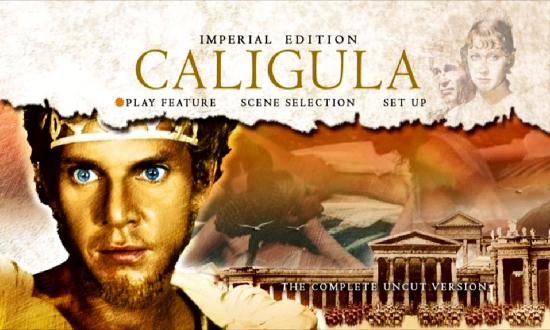
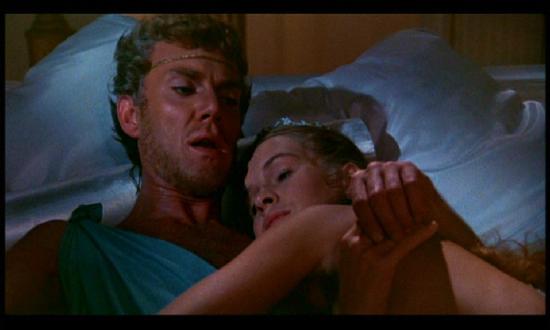
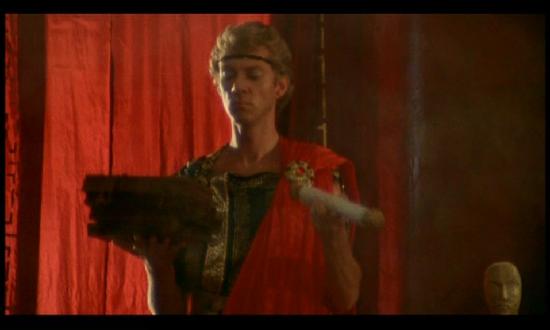
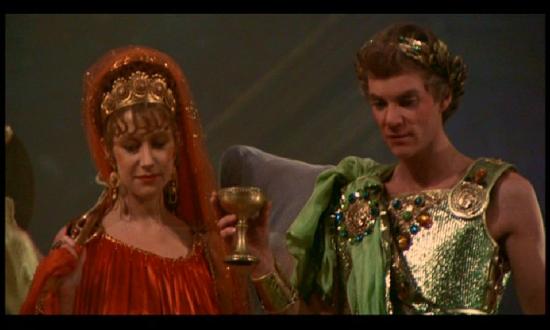
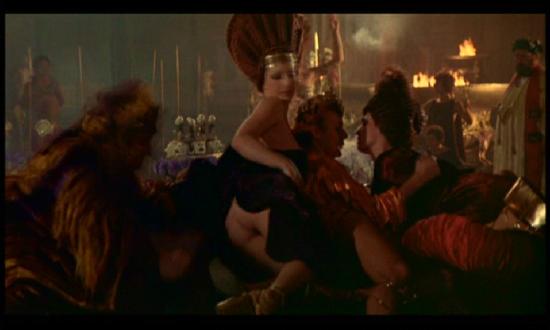
Your Opinions and Comments
Be the first to post a comment!